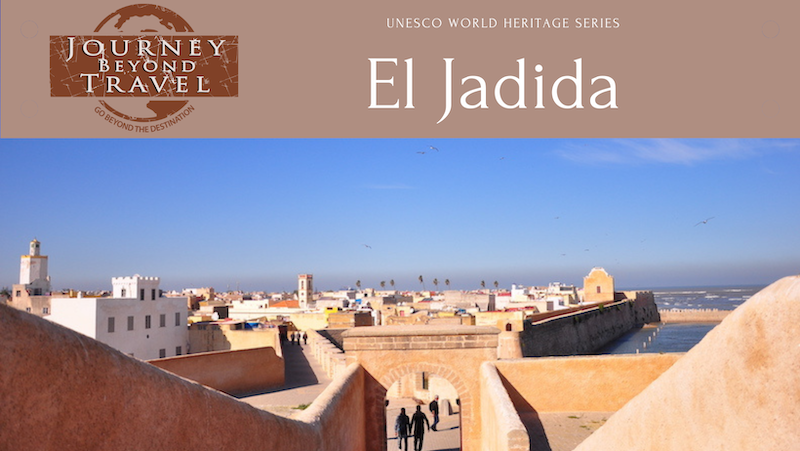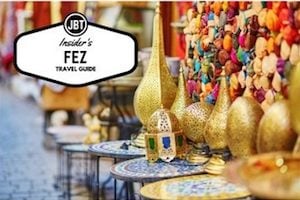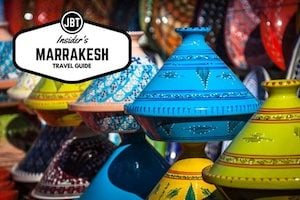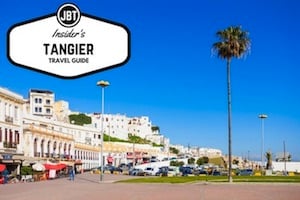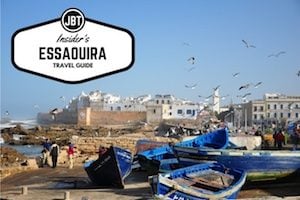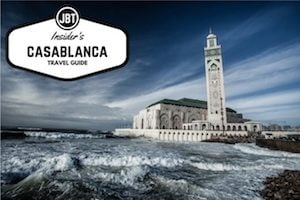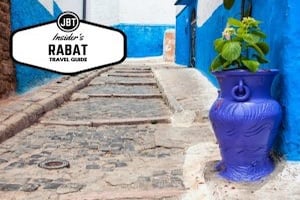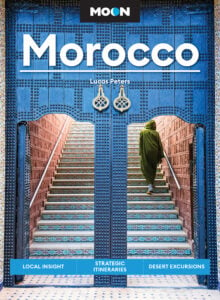As I stepped foot on the sun-kissed shores of El Jadida, a Moroccan coastal city steeped in history, I couldn’t help but feel a sense of wonder. This hidden gem, with its blend of Portuguese and Moroccan influences, promised to unveil a world of mesmerizing beauty and captivating tales. I found myself enchanted by the city’s UNESCO Heritage sites, which stood as testaments to its rich cultural heritage and historical significance. Join me as we embark on a journey through time and explore the wonders of El Jadida, where every corner holds a piece of a dreamy past.

Just an hour south of Casablanca, you can discover the Magic of Mazagan, nestled within the heart of El Jadida, lies in the enchanting Portuguese City, a walled fortress that transports you to a bygone era. Stepping through its ancient gates, I found myself immersed in a world where echoes of Portuguese architecture intertwine with Moroccan traditions. The harmonious blend of these two cultures creates a unique ambiance. Every cobblestone street, every whitewashed building, and every ornate window tells a tale of the city’s vibrant past.
Discovering the UNESCO Heritage Sites:
El Jadida is home to two UNESCO Heritage sites, carefully chosen to preserve its exceptional universal value. These sites are a testament to the city’s historical and cultural significance and embody the criteria set by UNESCO to honor their preservation. El Jadida answers two main UNESCO criterion which give it its well-deserved place on the list of UNESCO World Heritage Sites:
Criterion (ii): to exhibit an important interchange of human values, over a span of time or within a cultural area of the world, on developments in architecture or technology, monumental arts, town-planning or landscape design;
Criterion (iv): to be an outstanding example of a type of building, architectural or technological ensemble or landscape which illustrates a significant stage in human history;
El Jadida UNESCO World Heritage Site, The Cité Portugaise:
Nestled within the heart of El Jadida, stands as a living testament to the historical and cultural significance of Mazagan Portuguese City. This exceptional site showcases the profound exchange of influences between European and Moroccan cultures during the 16th to 18th centuries, leaving an indelible mark on the city’s architectural landscape.
As I ventured through the narrow streets of the Cité Portugaise, I was transported back in time to an era when El Jadida thrived as a Portuguese trading post. The architectural ensemble that adorns the city perfectly illustrates the fusion of European and Moroccan styles. The whitewashed buildings, adorned with intricately carved facades and ornate windows, speak of the Portuguese presence, while the vibrant colors and complex geometric patterns reflect the essence of Moroccan craftsmanship.
The defensive walls that encircle the Cité Portugaise are a testimony to its strategic importance during its heyday. These fortifications, built to protect the city from external threats, showcase the advanced technological expertise of the Portuguese during that period. Walking along the ramparts, I marveled at the panoramic views of the Atlantic Ocean, imagining the ships that once sailed these waters in pursuit of new trade routes and adventures.
Within Cité Portugaise, hidden treasures await discovery. A labyrinth of narrow alleyways leads to hidden courtyards, where the whispers of history echo in every stone. The fusion of European and Moroccan architectural elements creates a unique atmosphere that exudes charm and mystery. Every step taken within the Cité Portugaise unveils new wonders and invites contemplation of the cultural exchanges that took place between two distinct worlds.
One cannot overlook the significance of the Cité Portugaise in meeting the criteria set by UNESCO. As an outstanding example of a type of building or architectural ensemble, it serves as a reminder of a significant stage in human history. Its preservation allows us to appreciate the intricate connections between different cultures and the enduring legacy they leave behind.
The Cité Portugaise, with its amalgamation of European and Moroccan influences, is a living heritage that showcases the vibrant history and cultural exchange that shaped El Jadida. It is a place where the past seamlessly blends with the present, inviting visitors to immerse themselves in the beauty and complexity of the interwoven tapestry of cultures that continue to inspire and captivate.

El Jadida UNESCO World Heritage Site, The Portuguese Cistern:
Descending into the depths of El Jadida’s Portuguese Cistern, I discovered an architectural marvel that leaves visitors in awe of its sublime beauty and engineering ingenuity. This underground masterpiece, classified as a UNESCO Heritage site, holds a significant place in the city’s historical and cultural narrative.
As I stepped into the Portuguese Cistern, I was immediately enveloped in an atmosphere of intrigue and enchantment. The dimly lit chamber, supported by a forest of imposing stone columns, created a sense of grandeur and tranquility. The rhythmic sound of dripping water echoed through the cavernous space, adding to the ethereal ambiance.
The architectural design of the cistern is a true testament to the craftsmanship of its creators. The intricate network of vaulted ceilings, adorned with elegant arches and geometric patterns, showcased the mastery of Portuguese architecture during the 16th century. The clever use of natural light filtering through small openings created mesmerizing reflections on the water’s surface, transforming the cistern into an otherworldly spectacle.

Exploring further, I discovered that the Portuguese Cistern played a vital role in sustaining the city during times of scarcity. Its impressive capacity to hold vast amounts of water, a staggering 5,000 cubic meters, allowed El Jadida’s residents to endure through dry spells and sieges. It stood as a lifeline, providing water for drinking, irrigation, and the needs of the community.
The Portuguese Cistern’s inclusion as a UNESCO Heritage site is justified by its representation as a masterpiece of human creative genius. Its architectural ingenuity, coupled with its historical significance, showcases the remarkable achievements of the period. It is a testament to the importance of water management in El Jadida’s past and a symbol of the harmonious integration of Portuguese engineering with Moroccan sensibilities.
Walking through the Portuguese Cistern, I couldn’t help but feel a sense of reverence for the past. The interplay of light and shadow, the tranquility of the space, and the sense of awe-inspiring history all contributed to a unique and unforgettable experience. It was a moment of connection with the people who built and relied on this remarkable structure, a glimpse into their ingenuity and resilience.
In the heart of El Jadida’s Portuguese Cistern, time seems to stand still. Its architectural splendor and historical significance serve as a reminder of the enduring legacy of those who came before us. It is a place where dreams and reality intertwine, inviting visitors to step into a realm where the past comes alive, and the spirit of human creativity and innovation is celebrated.
Camera, Action: El Jadida’s Film Studios and Cinematic Legacy:
Beyond its architectural wonders, El Jadida boasts a rich history in the world of cinema. It proudly holds the title of being the birthplace of Moroccan cinema, a testament to its cultural significance. As I delved into the city’s cinematic legacy, I discovered that El Jadida played a pivotal role in shaping the Moroccan film industry. I could almost feel the magic lingering in the air. The sets, the props, and the behind-the-scenes secrets whispered stories of creativity and imagination.
A Hub of Creativity and Artistry :
The influence of El Jadida’s cinematic history extends beyond its physical boundaries. Its impact can be felt in the city’s cultural fabric, as well as in the hearts and minds of its residents. Cinematic events and festivals regularly grace the streets of El Jadida, captivating audiences and celebrating the art of storytelling through film. It is here that cinephiles can come together, revel in the magic of cinema, and share their love for the silver screen.

El Jadida, with its UNESCO World Heritage sites and undeniable allure, leaves an indelible mark on the hearts of travelers. Its ability to seamlessly blend Portuguese and Moroccan influences creates a dreamscape that feels both familiar and surreal. As I reluctantly bid adieu to this enchanting city, I couldn’t help but feel grateful for the opportunity to witness the preservation of its unique heritage. El Jadida is truly a place where time stands still, and where dreams and reality intertwine to create an experience that is nothing short of magical.
About the Author

Omar is an American-Moroccan who grew up in Washington DC before moving to Morocco, where he has lived in a few different places including Fez, Meknes, Ifrane and Rabat. Omar always keeps one foot in each country and is very comfortable navigating through both cultures. Omar currently lives in Rabat working in the development sector and pens the occasional deep-dive travel article. He has been working with Journey Beyond Travel since 2022, where he leverages his know-how to help travelers plan the trip of a lifetime… and a few of his own journeys as well.

